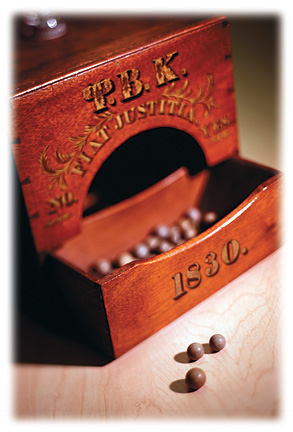In this year's Commencement program, beside the names of 148 graduates were symbols indicating membership in Phi Beta Kappa: a f for those students elected as juniors and a F for those chosen as seniors. Two graduate students were also admitted. Brown's chapter stipulates that fewer than one-sixth of a class can be chosen. The sole criteria are intellectual and moral character.

In the early days members used the mahogany box pictured at right for elections, voting with small stone balls. (The word ballot derives from the Italian ballotta, or little ball.) Nowadays, each member receives a key-shaped watch fob engraved with the Greek letters F B K and a hand pointing toward three stars.
Until 1832, Phi Beta Kappa was a secret society. Associate Professor of English Stephen Foley, historian of Rhode Island Alpha, says that at their initiation each year, members still learn a secret handshake—one he declined the offer to demonstrate.
Photo by Erik Gould.




